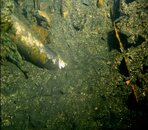I love to bash Scubapro. They're the 800# gorilla. But of course, in the real world, their engineering and manufacturing techniques are superior. I have some qualms about their QC, as most of the regs I've purchased new in the past few years for teaching material have been poorly adjusted.
Mk25, Mk19EVO x2, Mk11, D420 x3, S270 ‐ only one of these new purchases (Mk11) was ready to dive. But if the shops adjust them before they go out the door? No problem.
Yeah, in the floaty grit world of beach diving, I'm a little hyper-aware of trapped grit at the piston head o-ring. But also yeah,
@happy-diver is right: you can keep a piston sealed at 135 psi over all sorts of cobblestone corrosion, with or without polishing the seal. But if they'd all been sealed with messy goop they'd still be pristine. Except...messy goop.
Here's why I keep harping on this and stirring you guys up. I'm not so focused on those awful examples whose pics I keep posting every year. They're just 20 regs over all these years whose pictures I keep because they show the problem, from minor beginning to awful end.
No, what breaks my heart is the customer who I eventually sold a Mk19EVO to, when his UNsealed Atomic B2 died after a decade. He lived in the tropics; he owned a resort; he was a 0/10 when it came to preventive maintenance.
Things were pretty filled with verdigris the first service. But a little time in the ultrasonic cleaned him right up. Two years later, he sent the same thing back to me (now at about 10 years total reg age). Now, the ambient holes were bubbling every five seconds or so. Just a tiny bubble.
A quick polish to the piston head seal and a new HP oring and it was still happening. It was slow enough that you could actually tell by tilting the reg underwater that the air was coming from the piston head side.
So I started to polish the piston head sealing area in the body again with a little 8,000 grit Micromesh, and decided to look under the microscope. The area was
filled with pits that propagated under the chrome. When you polished to the bottom of one microscopic scratch, a whole array of gaps opened up. I could not fix this short of replacing the body (which I did when he left the reg with me in trade for a new Mk19EVO).
Un-rinsed salt crystals (and coral debris?), scratching the reg at every first pressurization, had worn through the chrome in microscopic areas in the space of a few years. Continued neglect after my first gentle scolding (because life and business just got in the way of attention to his gear) continued the corrosion until the reg was toast within a decade.
So I'm a guy that wants a valve to work forever, if the only parts rubbing against each other are chrome against rubber. When a design allows the accumulation of crystalline debris at a critical seal, I'm offended. If you can fix it with an overnight soak in the sink and a good flush, you can make it work for 50 years. But the average diver does a marginal job of that, and that's how I get my pictures, as well as an excuse to stir the pot here on SB.
From a purist's POV, an unsealed piston in salt water is planned deterioration. But if you don't look for a problem, you won't find one. These toys are pretty robust, and how many divers check their gear with an IP gauge and submerged observation every year?
So for every OP that posts, "Do we really need a $60 Christo-lube fill?", I'll say "Heck, yes!"
And all my friends here on Scubaboard will say, "Naw!". And we're both right. Just depends on your POV.






